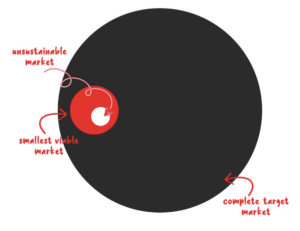General Business Strategy
Could Fewer Customers be the Key to Success for SMEs..?!
More customers, more growth, more profitability – that’s what we’ve all learned to chase, isn’t it..? And yet, they’re often accompanied with more complexity, more hassle, a strain on resources, and if you’re in a service-oriented industry, more time spent with clients that’s difficult to charge for.
Ever heard this one?
“This business would be fantastic if it wasn’t for the customers!”
One way to solve all this , of course, is by having less customers.
Shocked? You shouldn’t be! After all that’s what targeted marketing is all about, and it’s very common to select a market niche.
Having fewer customers is actually a fantastic growth strategy for a business. The secret is identifying the ‘Smallest Viable Market’, and you’ll be surprised when we explain the upsides…. increased efficiency, stability and profitability being three you’ll surely welcome.
What is a ‘Smallest Viable Market’?
It’s a new (ish) term, that further refines the age-old strategy of niche marketing, and it’s all about tailoring your offering more specifically to a smaller number of clients. The idea being that you can deliver a much better service, if you’re not trying to cater to everyone under the sun.
There’s a business called ‘Ladies Behind the Tradies’, for example, that provides bookkeeping services to tradespeople. A great niche that allows them to tailor their whole service around their needs.
Now, let’s say they focused only on left-handed electricians; that might be ‘niching down’ just a bit too much, and dropping below the Smallest Viable Market level required to run a successful business.
But how would they know? Well, they would need to identify just how many clients they needed to run the business – by doing the exercise below and see if the new niche is enough to support that.
The key here, is putting a number on it – not just the size of the niche, but the smallest number of individuals (or organisations) within it that can sustain us.

So how do you determine your Smallest Viable Market?
It’s not that complicated really…
- Establish how much revenue you need
What’s the minimum amount of annual gross revenue required to fund the business?
You probably know this already, but if you haven’t figured it out in a while, it’s a good exercise to do. Focusses the mind if nothing else.
- Calculate (or forecast) the average value of each client
This should be pretty easy if you have a reasonable number of clients of a period of at least a handful of years. Harder if you’re building a new business, in which case you’ll have to use some intelligent forecasting. Whatever situation you’re in, once you’ve got that, the next step is easy.
- Figure out how many clients you need
Divide your revenue by the average client value and there’s your number… your Smallest Viable Market.
Let’s say your revenue need is $2m, it could be four big clients delivering $500,000 each, or 50 smaller clients at $10,000 each, depending on what you sell. Can you see how this will help you focus on a very defined section of your niche as well as helping dictate your marketing tactics?
Of course, taking the first example of four clients, if you don’t reckon there are four clients out there with $500K to give you, then you need to think again…
What are the benefits of a Smallest Viable Market?
You’ll get better at what you do.
By focusing on a smaller, more niche market than you’re probably used to, it means you’ll get to know your prospects better, fit your solution much better to their needs and serve them better too – and in fact aim to delight them.
Your marketing will be more effective and more cost-efficient
With a tighter focus, you’ll be able to develop messaging that talks exactly to the needs, wants and pain points of your target, as well as spending only as much money to reach them as necessary, reducing media wastage.
It’ll be easier to win clients
A tighter focus means you can, focus more sales effort on fewer leads. Conversion should increase. See how everything starts to work together to streamline your operation?
You can eliminate the competition.
Being a bigger fish in a smaller pool means you can dominate it, pushing out less focused competition.
You’ll find it easier to grow your business.
When you put a stake in the ground, people flock to it, and when you focus on that smaller market you often find it’s actually a lot bigger than you first thought. We see this time and again with many of our clients, as they niche down, focus, and find it easier to grow their business.
Your clients may even become advocates
If you get all of the above spot on, you’ll find your clients absolutely love what you do, and they’re much more likely to turn into brand advocates, recommending your service to others too. Spread your effort too thin and this is very hard to achieve.

And if you like the sound of all of that, now it’s time for the most exciting part…
How do you find your Smallest Viable Market?
The following steps will help you find the perfect niche for your business, refine your messaging, launch your new service and start pursuing your Smallest Viable Market!
- Research, research, research
Sounds obvious, but needs to be done, especially if you’ve already been serving the larger market for some time now. Pre-existing thoughts may be clouding your judgement, so try to keep an open mind, and look at the market with fresh eyes.
You should carry out surveys and interviews with customers and prospects. Find out what research is already out there, and if you can afford it, perhaps commission some research of your own. That could make it easier to discover a niche that nobody else knows about, yet.
Review and analyse this body of work, searching for sub-markets not being served as well as they could be.
- Identify the kind of people you want to serve
Who’s your ideal customer? What problems are not being solved as well as they could be? What do they look for in a service provider? What alternative options are they using right now? Are they currently being underserved in any way? How many of them are they? Taken as a group, do they constitute a suitable niche?
- Narrow your focus even more
Next, try to find a core within that niche target. At this stage it could be based on demographics, location, interests, preferences or a host of other factors. When you start to dive into the audience deeper, something will appear that just makes sense.
Keeping in mind, of course, that you don’t want to go too narrow, but just enough to sustain your business, and grow from a position of strength. Try using an SEO tool to find out how many people are searching for some relevant terms, and that might help you along too.
- Review your Customer Value Promise (CVP)
A Customer Value Proposition is a refined, carefully written piece of work that identifies why customers should choose you, and not someone else. It’s the absolute essence of what makes your product, or service, unique and valuable to your Smallest Viable Market, and it’s going to be extremely useful in spreading the words across your organisation.
We’ve written more about developing a Customer Value Promise right here and here if you’re interested.
- Get stuck into the communications!
After all that hard work, this should be the fun part, where you get creative about how to communicate with your Smallest Viable Market. You’ll develop sales and marketing strategies, and campaigns that cut through all the other noise out there, targeting your specific niche with messages they’ve never heard before, solving problems they never thought could be solved.
- Evolve and make the most of it!
Once you’re up and running, and it seems to be doing the trick then you’re into a variety of tactics that lots of businesses should be doing anyway.
– Build great relationships with your clients
Easier because you know them better, and you’re serving their needs much better.
– Build remarkability into your service
Ensuring they’re not only delighted with the service you provide, but they’re also
delighted with the way that you do it! More on building remarkability into your business right here.
– Build a community
If it’s relevant, and you can manage it, creating a forum or events where all these like-minded people can engage and support each other, all hosted by you, of course. It’ll all encourage referral.
8. Monitor and improve
Last thing to remember, is that you need to monitor the new service, and how it’s being received by your clients. Make tweaks when necessary, and you’ll stay on top of your game with less customers, less hassle, and more potential for growth!
Oh, and once it’s successful, you can get back to the drawing board, do it all over again and launch another new service!
So what do you think? Could fewer customers lead to growth for your business?
Don’t forget, even AirBnB started as a small business, with a small team and limited budget.
They started by focusing on their smallest viable audience, and you can hardly deny their subsequent growth!
“It was better to have 100 people who loved us vs. 1 million people who liked us. All movements grow this way. There was no way we could get 1 million people on Airbnb, but we could get 100 people to love us.”
Brian Chesky, Founder & CEO of Airbnb
As always, if you need any help with all of this, please let us know and we’ll be happy to guide you along.





